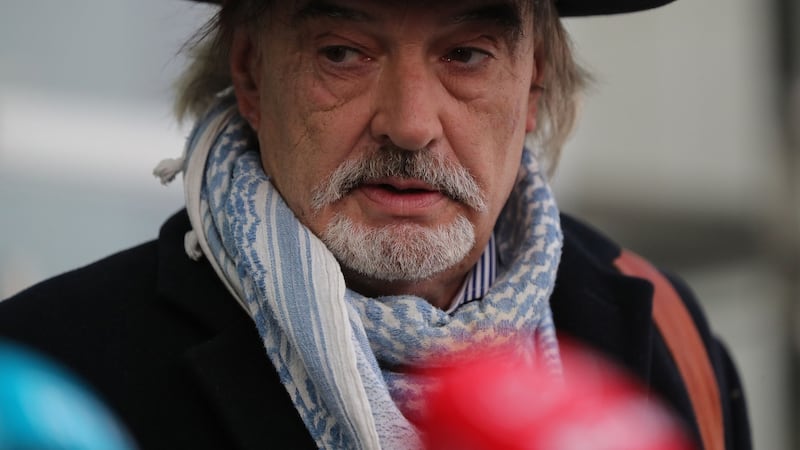A brutal murder at the ends of the earth. Allegations of bungled police work. A suspect seemingly addicted to the spotlight. Lawsuits and retracted confessions. And, at the centre, a French woman we know only through a handful of faded photographs from a quarter of a century ago.
With so much horror, drama and alleged bungling it is no surprise the unsolved murder of Sophie Toscan du Plantier should be irresistible to documentarians and true-crime buffs. And this month two sprawling new series revisit the December 1996 killing of the French film-maker at her holiday cottage near Schull, in west Co Cork.
Yet, starting from the same place, Jim Sheridan’s A Murder at the Cottage, streaming on Sky Crime, and Netflix’s Sophie: A Murder in West Cork, arriving this Wednesday, spin very different stories. Watching the former, you come away as baffled as ever about the case. The latter presents a clearer picture, particularly when it comes to a potential culprit. But which is closer to the truth?
Sheridan’s five-part investigation unfolds as a noirish mystery while posing questions that go beyond the grisly nuts and bolts of the Toscan du Plantier case. It’s a rumination on evil in paradise – which is how Sheridan sees bucolic Schull – and on truth and memory.
Sophie: A Murder in West Cork feels far more familiar, especially if you’ve binged on the likes of Making a Murderer and The Keepers. Shimmering with Netflix gloss, its three episodes zip by. Made with the co-operation of the Toscan du Plantier family, it also takes a firmer line than Murder at the Cottage on the guilt or innocence of the chief suspect, Ian Bailey, who has repeatedly denied any involvement in the murder.
But which documentary is better? Until the truth about Toscan du Plantier’s death is finally established, it’s entirely subjective. Here is a point-by-point comparison.
What they say about Sophie Toscan du Plantier
Murder at the Cottage Toscan du Plantier is an elusive figure in the Jim Sheridan documentary. The My Left Foot director, fascinated with the case since the discovery of the victim's body, two days before Christmas 25 years ago, portrays her as an inscrutable figure – an unknowable mystery at the centre of a tragedy.
That isn’t to say he isn’t curious about her. We learn about her marriage to Daniel Toscan du Plantier, a movie producer, and see the couple together on the red carpet.
“She never liked going to Cannes. She went and took refuge in Ireland,” says one contributor. “That’s why she bought the house. She loved Ireland; she went to learn English. If she were to buy a house it would be in Ireland.”
Sheridan interviewed the family, but they requested their comments be removed, regarding the series as too sympathetic to Bailey. So while her son, Pierre Louis Baudey-Vignaud, features extensively, it is entirely in the form of archive footage.
Sophie: A Murder in West Cork With the victim's family co-operating with director John Dower (and with her cousin an associate producer), it's no surprise that Sophie delivers a fully rounded portrait of Toscan du Plantier. We accompany Pierre Louis as he visits her west Cork holiday home – the place where he feels her presence most strongly.
And there is more background on her career as a producer. She was very much in the tradition of French intellectual film-makers; her lifelong ambition, for instance, was to make a film about different sorts of body fluids. So we see her not only as a victim – a face smiling from one of the handful of photographs of her that remain – but also as a woman of passion and possessed of a fierce curiosity. And as someone who flinched from the spotlight, preferring the solitude of west Cork.
What they say about west Cork
Murder at the Cottage Sheridan largely resists the temptation to caricature west Co Cork as a hippy playground. He does recycle the trope of newcomers to the area being regarded as blow-ins – although this is, of course, a feature of life throughout Ireland. He goes on to locate the seam of melancholy that coexists with the farmers' markets and organic-granola stalls.
“I don’t ever think I’ve been in as lonely a place,” he says as he walks Three Castle Head, the crumbling Dark Souls-esque landmark that Toscan du Plantier visited on the eve of her murder.
“On wintry days the force of the wind coming in off the Atlantic raises a froth on the lake that can appear like a white lady who is said to walk the lake. It’s best not to see her, because if you do you won’t see another day.”
Here Sheridan goes past mere true crime and deep into the west Cork psychosphere.
Sophie: A Murder in West Cork West Cork isn't of huge interest to Dower. He sets the scene much as Sheridan does, talking about blow-ins and bringing together a colourful mix of artisans and creative types and plain-speaking locals.
The former include the writer and poet Elizabeth Wassell, the latter a Schull resident named Florence Newman. Yet the series lacks the dramatic sense of place that Sheridan conjures (via some admittedly purple monologuing). Once Dower gets into the weeds of the case, west Cork as a character in the drama fades.
What they say about Ian Bailey
Murder at the Cottage Sheridan spends time with Bailey and gets to know him. And when the director goes to Paris, where a court finds Bailey guilty of the murder in absentia, he is constantly on the phone to the accused – while a camera crew beds down with Bailey in west Cork.
Bailey comes across as a narcissistic eccentric, but Sheridan does not present him as a monster. Is he an attention-seeking murderer? Or a victim, wrongly accused by the Garda? Sheridan is never quite able to make up his mind.
Yet while he is ruminating on Bailey’s guilt or innocence, the director draws a vivid portrait of someone falling apart. At the 70th-birthday party of his (now former) partner, Jules Thomas, Bailey drinks and drinks and then takes to the stage to serenade his mortified significant other.

“He was doing very well when he was on AA,” she says. “I’ve told him: he can choose me or alcohol.”
“I’m in a funny position,” Bailey tells Sheridan. “Halfway between the dog house and the jail house.They haven’t ruined my life. But they’ve ruined Jules’s life.”
Sophie: A Murder in West Cork Bailey is cast in a more straightforwardly villainous light in the Netflix documentary. He is interviewed extensively, but, in contrast to Sheridan's film, Sophie: A Murder in West Cork isn't particularly interested in getting inside his head.
And we are reminded of Bailey’s capacity for violence and his horrific assault on Thomas in May 1996, as a result of which she ended up in hospital. (This is also acknowledged by Sheridan, who shows us photographs of Thomas with one eye bandaged.)
Bailey cuts a sinister figure throughout. In one scene, as he is making a point, he lurches towards the camera, before stopping and apologising. And the final word goes to Baudey-Vignaud. “It’s clear he killed her. The judge said it,” he says of Bailey. “What happens next? I don’t know. If Bailey continues to slip through the net, I assure you I will make sure the net comes down on Bailey.”
What they say about the Garda
Murder at the Cottage This is where the two documentaries diverge most sharply. Sheridan chronicles alleged bungling by the authorities in great detail. He begins with the 24-hour delay in conducting an autopsy because of the unavailability of the State pathologist at the time, John Harbison, and the decision to leave the victim's body exposed to the elements during that time. (Netflix does not deal with this.)
Sheridan speaks to Frank Buttimer, Bailey’s solicitor, and to Marie Farrell, the key witness who claims gardaí pressured her to falsely testify that she saw Bailey at a bridge near the murder scene on the night of Toscan du Plantier’s death.
“There was nothing for me to gain by changing my statement for my story,” says Farrell. “I thought it was time to tell the truth and stand up to the guards.They told me he did it. [But] if he did do it, why would they need to manufacture all this stuff around him?”
The claim gardaí were waging a campaign against Bailey, Jules Thomas and anyone close to them is supported by Saffron Thomas, Jules’s daughter. “After a certain point they were just harassing us,” she tells Sheridan. “They didn’t have any more questions to ask. The guards are saying, ‘We know he did it, we know he did it.’ How appalling is that? Lots of people believe the guards ... My friends had fallen away. Every time you’d meet with friends, the guards would call around the next day and want a full interview with people – and not leave people alone. Actually, it was quite cruel.”
Sophie: A Murder in West Cork The Netflix documentary gives the benefit of the doubt to the gardaí and approaches the case from the perspective of the Toscan du Plantier family, who are firmly convinced of Bailey's guilt. And where Sheridan takes the view that Farrell's testimony about a Garda conspiracy against Bailey is plausible, Sophie: A Murder in West Cork sees her as unreliable.
The key evidence put forward is her meltdown during Bailey’s unsuccessful 2014 lawsuit against the State, during which she temporarily leaves the witness stand. “She was telling lies non-stop,” says one of the gardaí involved in the case. “She didn’t know what she was saying.”
Omitted from the documentary is the testimony of the late Martin Graham, who claimed gardaí had asked him to spy on Bailey and attempt to extract a confession.
What they conclude
Murder at the Cottage Sheridan doesn't comes to a categorical conclusion about Bailey's guilt or innocence. But he clearly believes the suspect was targeted by gardaí – and paints a scathing portrait of alleged police incompetence. And he is sceptical about the French conviction in absentia.
“Without scientific proof, with retracted statements, with absent witnesses and no interrogation of the facts ... the French have proved him guilty,” says Sheridan. “Is he capable of murder? Aren’t we all? Is he guilty? I don’t know. I don’t think we can say for sure.”
Sophie: A Murder in West Cork Like Sheridan, Dower doesn't make a definitive pronouncement on Bailey's guilt or innocence. But the documentary is sympathetic towards the Toscan du Plantier family's perspective and suggests the director of public prosecutions erred in deciding not to prosecute Bailey and in attaching greater plausibility to the suspect's statements than to those of many witnesses.
There is also testimony from a friend of Thomas’s daughter Ginny, Arianna Boarina, who visited the family days after the murder and saw Bailey’s coat soaking in a bucket in the bathroom. She also noticed scratches on his arms (which Bailey told gardaí he got when cutting down a Christmas tree). And we are reminded that Bailey allegedly confessed to the murder to 14-year-old Malachi Reed, not long after Toscan du Plantier’s death.
“It doesn’t sit well,” says Malachi’s mother, Amanda Reid. “This person can cause so much pain and carries on skipping on by.”




















